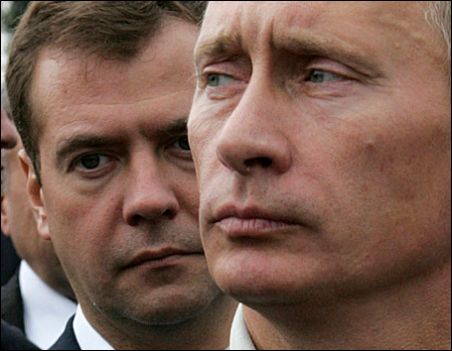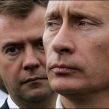
Medvedev’s “Modernization” of Russia: Forward to the Past
Publication: Eurasia Daily Monitor Volume: 7 Issue: 204
By:

In the image contest between the Russian President, Dmitry Medvedev, and Prime Minister, Vladimir Putin, in anticipation of the 2012 presidential elections, Medvedev appears as a tech-savvy proponent of innovative projects (EDM, October 25). However, he is hardly innovative in his choice of the means to achieve the noble goal of Russia’s modernization. Like many Russian rulers before him, he seeks to import ready-made foreign solutions most of which have already become obsolete. Once again, the Russians are not given the chance to work out their own way to the future, but are compelled to live someone else’s past.
As the ancient chronicles recorded, it was in the 9th century that the wise men of what is now Russia, first came to a sad conclusion that their country is “great and rich, but lacks in order” and invited Varangians to modernize it. Since then, a number of monarchs tried awaking Russia to the glory of being a modern nation by buying her, with her riches, whatever forms of modernizations other nations had developed by then. Russia acquired a “European-like” army, a navy, a new capital (St. Petersburg) abolished serfdom and finally gained a parliament. But the reforms little improved the main population’s living conditions, their rights and freedoms or access to civil services, such as education, healthcare or an independent judiciary. A thin layer of educated classes emerged though, themselves prone to an excessive European influence, whether in culture, science, administration or politics.
Influenced by Marxism, the Bolsheviks launched a modernization at an unprecedented scale in 1917. In the 1920’s and 1930’s they imported American and European engineers, machines and technologies. In the 1960’s and 1970’s, some western management practices were borrowed, without acknowledging their origins, such as the scientific organization of work (NOT) and the production quality controls (OTK), developed in the US and Japan in the 1910’s and the 1940’s. Some 70 years of Soviet modernization effort and millions of Russians perished in the process, the country came to pride itself in its vast stock of nuclear and conventional weaponry, space technologies, and a number of scientific centers, mostly military-related, while people struggled with food and consumer goods shortages, inadequate housing and Lada cars.
With reformers impressed by Friedrich August von Hayek and the Harvard economic school, the “shock therapy” of market liberalization and the wholesale privatization of the state assets followed. Two decades of relentless reforms later, Russia suffers de-industrialization and has to import virtually everything, from nappies to oil-drilling equipment, and the first item on the current president’s agenda is, once again, modernization and innovation.
Medvedev, impressed by Silicon Valley, a cradle of the American high-tech industry, during his visit to California last June, initiated building the innovative city of Skolkovo. The inception of this expensive project –in the next three to five years, 180-200 billion rubles (around $6 billion) of state and private money (50-50) is to be invested in this sector– has left most observers flabbergasted. Not only had Silicon Valley sprung up around Stanford University in the 1960’s, but its model was already reincarnated once by the Soviets, as the Zelenograd computer science center emerged near Moscow in the 1970’s, with other “science cities” scattered over Russia.
The point appears to be also lost on the president, that the advent of Internet technologies has made irrelevant the construction of innovation clusters as physical objects. The Skolkovo project has been compared to the de facto failed 2006 federal program of building techno parks in Russia elaborated after the then president Putin had visited Indian Bangalore in 2004. Given the high level of corruption in Russia, both projects have raised more questions as to the funds earmarked for their realization than there were answers provided (https://www.kommersant.ru/doc.aspx?DocsID=1356905&ThemesID=1227).
The primary goal of Medvedev’s modernization agenda seems to be ideological. The nation suffers a severe identity crisis and Medvedev has to produce an inspiring idea to maintain his popularity ratings in the run-up to the elections. With a lack of a cohesive secular or religious set of values, but with rising social differences and plummeting cultural, educational and scientific standards, the Russian nation is at a high risk of degradation. The territorial integrity guarded arduously as ever, some parts of Russia already seem to exist as if in different countries. Most of the educated classes, as under the Soviets, went into the “inner emigration” of their private lives. The mentality of the bulk of the population, still struggling with the basic living conditions, the independent judiciary hardly in sight, remains as archaic as ever, infested with abhorrent stereotypes and superstitions. According to a recent sociological survey, over 60 percent of the population has a paternalistic attitude to life and an inertia-dominated “rural” way of thinking (Kommersant, October 21).
Both, the president and prime minister, are keen to promote their respective big ideas, modernization and new infrastructure building, something for people to perceive as a common issue. Driven by the understandable desire to see the results of their efforts, they have, once again, reverted to a simple solution to a complex problem, choosing to import the foreign ready-made modernization receipts. But the imposition of patterns, originated in places and cultures most Russians have very vague perceptions about, while the population’s expectations remain unaddressed, only further deepens the national identity crisis.
Ironically, if a country is given a chance to mature naturally, over an extended period of time, the traits of modernization appear quicker and take deeper roots. At different times in history, such dissimilar countries as the US, Japan, Singapore, and China lived through comparable experiences of gradual modernization, first within their closed societies, and then under the tightly controlled openness. On the other hand, the case of the united Germany suggests that an imposed modernization leaves deep social scars. 20 years after the unification, East Germany’s transformation was extremely costly, is still unfinished and caused people a deep identity crisis as they often feel the second-rate citizens in their own country (https://www.perspektivy.info/oykumena/europe/naskolko_jedina_objedinennaja_germanija_vostochnyje_i_zapadnyje_nemcy_20_let_spusta_po_materialam_nemeckoj_pechati_2009-12-02.htm).
As the president of the Institute of the National Project “Civil Agreement”, Aleksandr Ausan, suggests, to be successful a strategy of modernization should have a long term perspective and be based on the national specifics, however backward it might seem. The anachronisms can be turned into resources, if the modernization is adapted to the values and traditions of a nation. That way, it would gather popular support strengthening the national identity (Ogonyok, October 25). The whole point of modernization is to show a nation a way to the future, not to push it to relive someone else’s past, however glorious.




